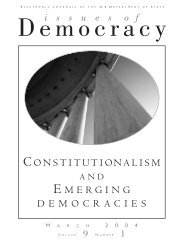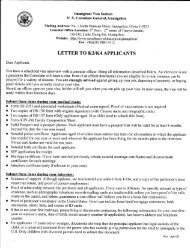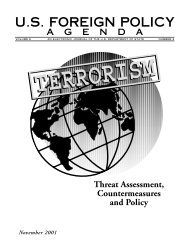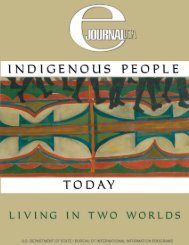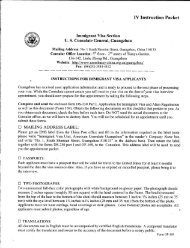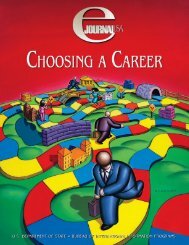s. history us history us history - Embassy of the United States
s. history us history us history - Embassy of the United States
s. history us history us history - Embassy of the United States
- No tags were found...
Create successful ePaper yourself
Turn your PDF publications into a flip-book with our unique Google optimized e-Paper software.
CHAPTER 12: POSTWAR AMERICAOUTLINE OF U.S. HISTORYready to investigate subversive activity,President Truman established aFederal Employee Loyalty Program.It had little impact on <strong>the</strong> lives <strong>of</strong>most civil servants, but a few hundredwere dismissed, some unfairly.In 1947 <strong>the</strong> Ho<strong>us</strong>e Committeeon Un-American Activities investigated<strong>the</strong> motion-picture ind<strong>us</strong>tryto determine whe<strong>the</strong>r Communistsentiments were being reflected inpopular films. When some writers(who happened to be secret members<strong>of</strong> <strong>the</strong> Communist Party) ref<strong>us</strong>edto testify, <strong>the</strong>y were cited forcontempt and sent to prison. Afterthat, <strong>the</strong> film companies ref<strong>us</strong>ed tohire anyone with a marginally questionablepast.In 1948, Alger Hiss, who hadbeen an assistant secretary <strong>of</strong> stateand an adviser to Roosevelt atYalta, was publicly acc<strong>us</strong>ed <strong>of</strong> beinga Communist spy by WhittakerChambers, a former Soviet agent.Hiss denied <strong>the</strong> acc<strong>us</strong>ation, but in1950 he was convicted <strong>of</strong> perjury.Subsequent evidence indicates tha<strong>the</strong> was indeed guilty.In 1949 <strong>the</strong> Soviet Union shockedAmericans by testing its own atomicbomb. In 1950, <strong>the</strong> government uncovereda British-American spy networkthat transferred to <strong>the</strong> SovietUnion materials about <strong>the</strong> development<strong>of</strong> <strong>the</strong> atomic bomb. Two <strong>of</strong>its operatives, Juli<strong>us</strong> Rosenberg andhis wife E<strong>the</strong>l, were sentenced todeath. Attorney General J. HowardMcGrath declared <strong>the</strong>re were manyAmerican Communists, each bearing“<strong>the</strong> germ <strong>of</strong> death for society.”The most vigoro<strong>us</strong> anti-Communistwarrior was Senator Joseph R.McCarthy, a Republican from Wisconsin.He gained national attentionin 1950 by claiming that he had a list<strong>of</strong> 205 known Communists in <strong>the</strong>State Department. Though McCarthysubsequently changed this figureseveral times and failed to substantiateany <strong>of</strong> his charges, he struck aresponsive public chord.McCarthy gained power when<strong>the</strong> Republican Party won control<strong>of</strong> <strong>the</strong> Senate in 1952. As a committeechairman, he now had a forumfor his cr<strong>us</strong>ade. Relying on extensivepress and television coverage, hecontinued to search for treacheryamong second-level <strong>of</strong>ficials in <strong>the</strong>Eisenhower administration. Enjoying<strong>the</strong> role <strong>of</strong> a tough guy doingdirty but necessary work, he pursuedpresumed Communists with vigor.McCarthy overstepped himselfby challenging <strong>the</strong> U.S. Army whenone <strong>of</strong> his assistants was drafted.Television brought <strong>the</strong> hearings intomillions <strong>of</strong> homes. Many Americanssaw McCarthy’s savage tactics for<strong>the</strong> first time, and public supportbegan to wane. The RepublicanParty, which had found McCarthy<strong>us</strong>eful in challenging a Democraticadministration when Truman waspresident, began to see him as anembarrassment. The Senate finallycondemned him for his conduct.McCarthy in many ways represented<strong>the</strong> worst domestic excesses<strong>of</strong> <strong>the</strong> Cold War. As Americansrepudiated him, it became naturalfor many to assume that <strong>the</strong> Communistthreat at home and abroadhad been grossly overblown. As <strong>the</strong>country moved into <strong>the</strong> 1960s, anti-Communism became increasinglys<strong>us</strong>pect, especially among intellectualsand opinion-shapers.THE POSTWAR ECONOMY:1945-1960In <strong>the</strong> decade and a half afterWorld War II, <strong>the</strong> <strong>United</strong> <strong>States</strong>experienced phenomenal economicgrowth and consolidated its positionas <strong>the</strong> world’s richest country. Grossnational product (GNP), a measure<strong>of</strong> all goods and services producedin <strong>the</strong> <strong>United</strong> <strong>States</strong>, jumped fromabout $200,000-million in 1940 to$300,000-million in 1950 to morethan $500,000-million in 1960.More and more Americans nowconsidered <strong>the</strong>mselves part <strong>of</strong> <strong>the</strong>middle class.The growth had different sources.The economic stimul<strong>us</strong> providedby large-scale public spending forWorld War II helped get it started.Two basic middle-class needs didmuch to keep it going. The number<strong>of</strong> automobiles produced annuallyquadrupled between 1946 and 1955.A ho<strong>us</strong>ing boom, stimulated in partby easily affordable mortgages forreturning servicemen, fueled <strong>the</strong> expansion.The rise in defense spendingas <strong>the</strong> Cold War escalated alsoplayed a part.After 1945 <strong>the</strong> major corporationsin America grew even larger. Therehad been earlier waves <strong>of</strong> mergersin <strong>the</strong> 1890s and in <strong>the</strong> 1920s; in <strong>the</strong>1950s ano<strong>the</strong>r wave occurred. Franchiseoperations like McDonald’sfast-food restaurants allowed smallentrepreneurs to make <strong>the</strong>mselvespart <strong>of</strong> large, efficient enterprises.Big American corporations alsodeveloped holdings overseas, wherelabor costs were <strong>of</strong>ten lower.Workers found <strong>the</strong>ir own liveschanging as ind<strong>us</strong>trial Americachanged. Fewer workers producedgoods; more provided services. Asearly as 1956 a majority <strong>of</strong> employeesheld white-collar jobs, workingas managers, teachers, salespersons,and <strong>of</strong>fice operatives. Some firmsgranted a guaranteed annual wage,long-term employment contracts,and o<strong>the</strong>r benefits. With suchchanges, labor militancy was underminedand some class distinctionsbegan to fade.Farmers — at least those withsmall operations — faced toughtimes. Gains in productivity ledto agricultural consolidation, andfarming became a big b<strong>us</strong>iness.More and more family farmers left<strong>the</strong> land.O<strong>the</strong>r Americans moved too.The West and <strong>the</strong> Southwest grewwith increasing rapidity, a trend thatwould continue through <strong>the</strong> end<strong>of</strong> <strong>the</strong> century. Sun Belt cities likeHo<strong>us</strong>ton, Texas; Miami, Florida; Albuquerque,New Mexico; and Phoenix,Arizona, expanded rapidly. LosAngeles, California, moved ahead <strong>of</strong>Philadelphia, Pennsylvania, as <strong>the</strong>third largest U.S. city and <strong>the</strong>n surpassedChicago, metropolis <strong>of</strong> <strong>the</strong>Midwest. The 1970 cens<strong>us</strong> showed266267



